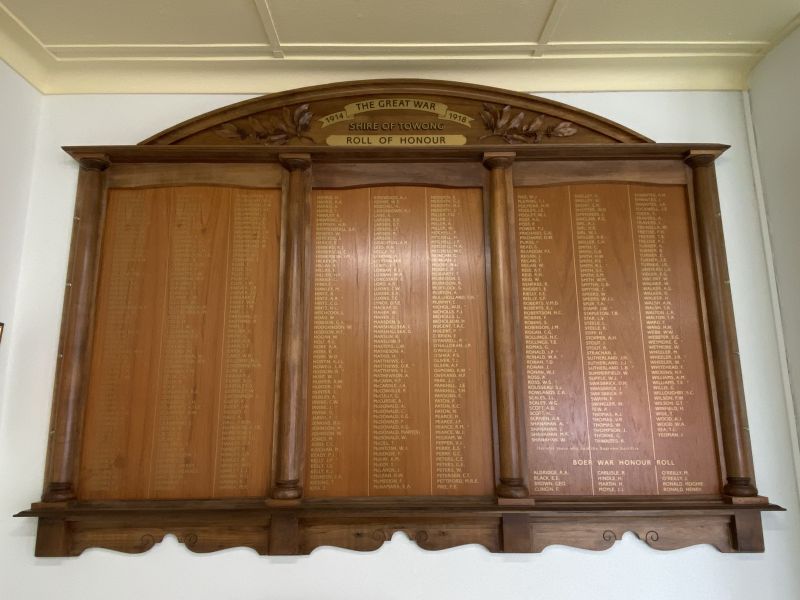Roy Leslie Smith
Roy was born at Tallandoon, Victoria, on the 18th of March 1895. He was one of fifteen children to William Thomas and Margaret Annie (née Urwin) Smith of Tallandoon. The Smith lived between Eskdale and Tallandoon at their home “The Acacias”. Roy’s father had acted as postmaster for the area. Roy attended the Tallandoon State School (No. 2533) and, after completing his formal education, worked as a farmer.
On the 29th of March, 1916, Roy made his way to the enlistment at Tallangatta where he underwent his medical examination. Nearly two months would go by before he completed his attestation papers and signed his way into the 1st AIF. He was placed amongst the 16th Reinforcements for the 21st Infantry Battalion and allocated the Regimental Noumber 5956. After three months at Royal Park he was posted to the 21st Depot Battalion.
In early October the 16th Reinforcements embarked on HMAT A17 Nestor at Melbourne. On the 16th of November of that year they disembarked at Plymouth in the south of England. Further training was then conducted at No. 3 Camp at Fovant in Salisbury. Roy spent two weeks in the hospital at the camp, although the reason for the stay is not listed in his records.Two months were then spent in the 6th Training Battalion at Larkhill. On the the 12th of February, 1917, Roy embarked on the SS Victoria at Folkstone and travelled across to France to join his battalion. He arrived at the battalion on the 24th of February.
In early November of 1917 he was admitted to the 3rd Canadian General Hospital suffering from enteritis, an inlfammation of the small intestine, and diarrhoea. He was evacuated to England via HS St. Andrew and admitted to the 2nd Eastern General Hospital at Brighton with trench fever. What followed was four months of rest and recuperation in hospitals and convalscent depots in Dartford, Hardcott and Longbridge, all in England.
Ray finally rejoined his battalion on the 1st of of May, 1918. By this stage the battalion had been relieved after helping to stop German forces during thier spring offensive. The 21st, along with its sister battalions in the 6th Brigade were being held at Querrieu in case another German counter-attack should take place. Things were relatively quiet on the Western front, with the Germans being exhausted after their failed offensive. In the Australian sector battalions were undertaking small raids and local operations. Australian patrols realised that the opposing forces had not had time to cretae solid defenses and that it was possible in some places to quietly infiltrate the enemy’s trenches. These minor stunts were often carried out without supporting artillery fire and became known as “peaceful penetrations”.
The 6th Brigade’s Brigadier General Paton devised a plan for a night attack on the village of Ville-sur-Ancre, although in this case artillery support was used. The plan was for the battalions of the brigade to push past the flanks of the village and then enter it from the north-east and north-west. The 21st Battalion’s line of advance can be seen in the trench map below, just south of the village, whilst the photograph shows the line of advance into the village.
Company Sergeant Major Charles Oliver of B Company was with Roy when he was killed.
“I knew Roy Smith well. He was a very good soldier, wonderfully plucky. He hoped to have been made an officer and would have made an excellent one. On the 19th we were making an attacked on Ville-sur-Ancre. He was second man into the village. After the attack, which was successful we were being shelled and took shelter in a sunken road. A shell fell close by and killed Smith instantly. Two other men were killed by the same shell. I saw his body afterwards. He was buried on the spot.”
After the war Roy’s remains were re-interred in the Ville-sur-Ancre Communal Cemetery, Ville-sur-Ancre, Peronne, Picardie, France. He is also remembered on the Australian War Memorial Roll of Honour, the Towong Shire Boer War and ww1 Roll of Honour, and the Tallandoon Hall Roll of Honour. For his service, he was awarded the British War Medal and the Victory Medal.

 Stephen Learmonth
Stephen Learmonth